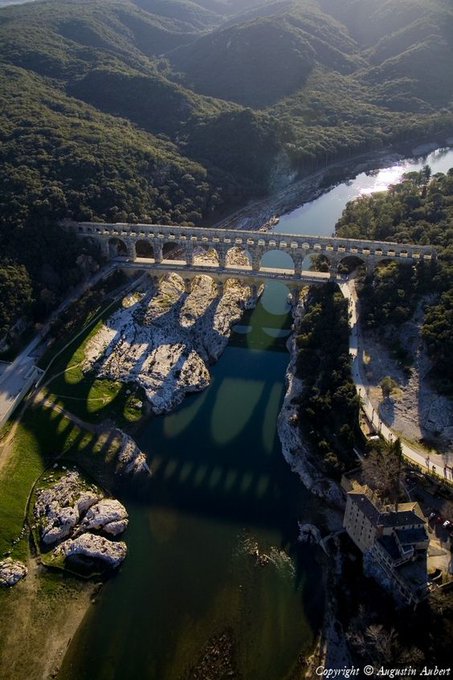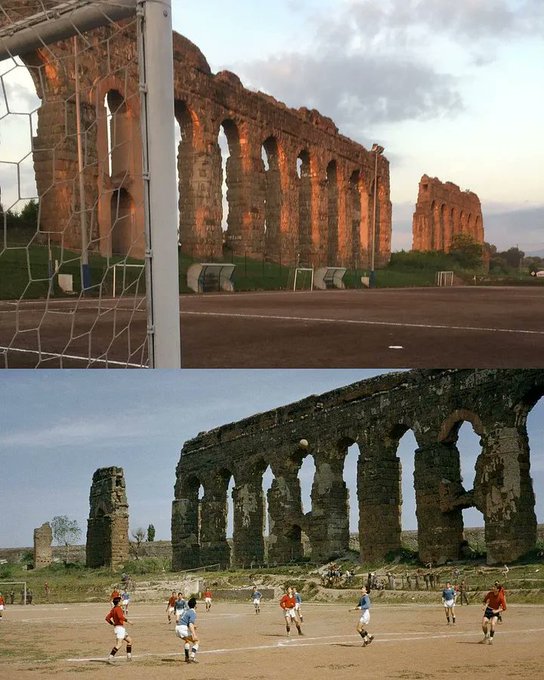- The House of Wisdom
- Posts
- Roman Aqueducts: the Arteries of the Empire
Roman Aqueducts: the Arteries of the Empire
The boldness of the enterprise, the solidity of the execution, and the uses to which they were subservient, rank the aqueducts among the noblest monuments of Roman genius and power.
The Romans built over 200 aqueducts — there were 11 in Rome alone.
Here are 10 Roman Aqueducts that everyone should know about (and visit at least once in a lifetime)...

1. Pont Du Gard, Gard, France (60 AD)
When you here of Roman aqueducts, this is probably the first one that comes to mind.
Believe it or not, Pont Du Gard was built mostly without mortar and was able to carry 44 million gallons of water daily to the Roman colony of Nemausus, which is the modern-day city of Nîmes. It is one of the highest surviving Roman aqueduct bridges (49 meters high across three tiers).

2. Aqueduct of Segovia, Spain (112 AD)
Also built mostly without mortar, it was reconstructed many times, most famously during 15th century by the Catholic Monarchs, Queen Isabella and King Ferdinand.
What makes Segovia’s aqueduct almost mythical is that that it was never lost to time. While many Roman monuments fell into ruin, the aqueduct kept working for 1,800 years and was comfortably used to supply water well into the 19th century. It was only replaced in 1973 by a modern water distribution system.

3. Aqua Claudia, Rome, Italy (52 AD)
Emperors Caligula and Claudius funded this 69 km aqueduct, allowing it to supply the city for over 400 years. It transported water from the Anio Novus and Caeruleus springs to Rome and was one of the four great aqueducts feeding the imperial capital. The other three were: Aqua Anio Vetus, Aqua Marcia and Aqua Anio Novus.
Parts of Aqua Claudia and Aqua Anio Novus were later integrated into into the Aurelian Wall in 271 AD.

4. Los Milagros Aqueduct, Mérida, Spain (300 AD)
Also known as the "Aqueduct of Miracles," it's one of the best-preserved Roman aqueducts and once supplied the Roman colony of Augusta Emerita.
“The boldness of the enterprise, the solidity of the execution, and the uses to which they were subservient, rank the aqueducts among the noblest monuments of Roman genius and power. “

Our subscribers get early access to editions of the House of Wisdom, before anyone else.
If you are enjoying the newsletter, you’ll want to consider subscribing to support our work and get more awesome content like this!
5. Aqueduct of Diocletian, Split, Croatia (4th century AD)
It was built to supply Diocletian’s massive palace, using water from a spring 9 km away. There was another aqueduct that took water from the same source to Salona, which was in practice the capital of the Western Roman Empire.
Parts of it were restored in the 1800s, thanks to the Austro-Hungarian Empire. It has long been replaced today but it still remains partially useful for agriculture.

6. Valens Aqueduct, Istanbul, Turkey (368 AD)
Commissioned by Emperor Valens, it was built in 28 years and today, it stretches for over 971 meters, being the longest aqueduct every built by the Romans.
But some recent findings suggest something shocking — all of its branches possibly stretched for over 336km (some suggest as high as 500km). That’s three times longer than what could have been found in Rome.

7. Aqueduct of Zaghouan, Tunis, Tunisia (128 AD)
It carried water for 132km, supplying the ancient city of Carthage. The water would flow into a gigantic network of reservoirs, known as La Malga Cisterns, that could hold 60,000 cubic meters of water. From there, water was distributed to baths, fountains and private homes across the city.

8. Pont d'Aël, Aosta Valley, Italy (3BC)
Not as famous as the rest but a nice example to admire.
Today, it’s as a bridge but its inscription still reminds us of the time of Augustus, the time of its construction.

9. Les Ferreres Aqueduct, Tarragona, Spain (14 AD)
Also known as the "Devil's Bridge" because of the belief that only the devil could build it to last for 1,000 years. We don’t really know when it was built, but most historians agree that it dates back to the time of Augustus, with restorations being made by Caliph Abd al-Rahman III in the 10th century.
Unfortunately, much of the aqueduct has been lost to time. Originally, it stretched for over 25km but today you can only walk across 217 meters.

10. Aqua Alexandrina, Rome, Italy (235 AD)
This was one of the last aqueducts ever built by the Empire with 10 out of its 14 miles being made up of arches. It was also the final aqueduct to be completed out of the 11 that supplied Rome.
Its arches are the highest at the crossing of Viale Palmiro Togliatti, pictured below. At first thought, it seems that the whole structure was built out of bricks, however, the arches were actually made of concrete, later layered with brick coating.

“If we take into careful consideration the abundant supplies of water in public buildings, baths, pools, open channels, private houses, gardens and country estates near the city; if we consider the distances traversed by the water before it arrives, the raising of arches, the tunnelling of mountains and the building of level routes across deep valleys, we shall readily admit that there has never been anything more remarkable in the whole world."
I hope you enjoyed reading today’s article!
You can help to keep our Friday editions free for everyone by subscribing to us on 𝕏. Plus you get access to bonus content and early insights, not published anywhere else.
You've seen it a thousand times before.
It's the Acropolis of Athens, in Greece.
You already know about the Parthenon, but what about all the other buildings surrounding it?
Well, that's where it gets interesting... 🧵
— World Scholar (@WorldScholar_)
7:21 PM • May 8, 2025
Until Next Time,
World Scholar

P.S. Thank You for getting this far! What topic should we dive into next? Let me know directly by replying to this email!
Reply